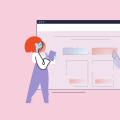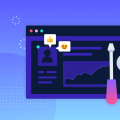In today's digital age, chatbots have become an integral part of the user experience for businesses across various industries. With the rise of conversational interfaces and voice technology, chatbots have evolved from simple text-based assistants to sophisticated virtual agents capable of handling complex tasks. However, designing a chatbot that truly enhances the user experience and engages customers requires more than just programming skills. It involves understanding the best practices for chatbot design and incorporating them into the development process.
In this article, we will explore the latest trends in UI and UX design and how they can be applied to chatbots to improve their effectiveness. Whether you are a business owner looking to integrate a chatbot into your customer service strategy or a designer seeking to enhance your skills, this article will provide valuable insights on how to design a successful chatbot. So let's dive in and discover the best practices for chatbot design that will elevate your customer experience to new heights. To begin, let's discuss the importance of a user-centered design when it comes to chatbots. Unlike traditional websites or mobile apps, chatbots rely heavily on user interaction.
Therefore, it is crucial to consider the user's needs and preferences when designing a chatbot. One way to achieve this is by conducting user research and testing to gather valuable insights on how your target audience would like to engage with your chatbot. Another crucial aspect of chatbot design is incorporating responsive design. As chatbots can be accessed on various devices, including smartphones, tablets, and desktops, it is essential to ensure that the interface is optimized for each device's screen size and resolution. This will enhance the user experience and make it easier for users to interact with your chatbot. In terms of design trends, voice and conversational interfaces are gaining popularity in the chatbot world.
This means that your chatbot should be able to understand natural language and respond in a conversational manner. This can be achieved through the use of AI and NLP (Natural Language Processing) technologies, which are becoming increasingly advanced and accessible for designers. Lastly, we will provide some resources and tools to help you with your chatbot design projects. These include chatbot design platforms, prototyping tools, and AI/NLP technologies. By utilizing these resources, you can create a well-designed and functional chatbot that will engage and delight your users.
Creating a User-Centered Design
Creating a user-centered design is crucial for the success of any chatbot.It involves understanding the needs and preferences of your target audience and incorporating them into the design process. One of the most effective ways to gather these insights is through user research and testing. By conducting user research, you can gain a better understanding of your target audience and their expectations from a chatbot. This can include their preferred communication style, common pain points, and desired outcomes. You can use various methods such as surveys, interviews, and focus groups to gather this information. Once you have gathered these insights, it is important to test your chatbot design with real users.
This will help you identify any usability issues or areas for improvement. It is also important to continually gather feedback from users and make necessary adjustments to ensure that your chatbot design meets their needs.
Incorporating Responsive Design
use HTML structure with responsive design only for main keywords and Incorporating responsive design in chatbot design is crucial for enhancing user experience and engagement. With the increasing use of chatbots on various devices, it is essential to optimize the interface for different screen sizes and resolutions. This not only improves usability but also ensures a seamless experience for users, regardless of the device they are using.Responsive design involves creating a layout that adapts to the device it is being viewed on. This means that the chatbot interface will look different on a smartphone compared to a desktop computer, but it will still maintain its functionality and user-friendliness. It is important to consider the limitations and capabilities of each device when designing a chatbot, to ensure that the interface is optimized for that specific device. By incorporating responsive design in chatbot design, designers can provide a consistent and visually appealing experience for users across all devices.
This not only improves user satisfaction but also encourages engagement and increases the likelihood of users returning to use the chatbot again.
Resources and Tools
Designing a chatbot can be a complex and challenging process, but there are many resources and tools available to help make the task easier and more efficient. In this section, we will discuss some of the top platforms, prototyping tools, and AI/NLP technologies that can aid in creating a successful chatbot design.Chatbot Design Platforms
One of the most important resources for chatbot design is a platform specifically designed for creating chatbots. These platforms provide all the necessary tools and features to build, test, and deploy a chatbot without any coding knowledge. Some popular examples include Chatfuel, ManyChat, and Dialogflow.These platforms offer a user-friendly interface, customizable templates, and integrations with various messaging apps.
Prototyping Tools
Prototyping tools are essential for visualizing and testing the design of a chatbot before it is built. These tools allow designers to create interactive prototypes of their chatbot, which can help identify any potential issues or improvements in the design. Some commonly used prototyping tools for chatbots include Botsociety, Botmock, and Marvel.AI/NLP Technologies
Artificial Intelligence (AI) and Natural Language Processing (NLP) are crucial components in chatbot design as they enable the bot to understand and respond to user queries in a human-like manner. There are various AI/NLP technologies available that can be integrated into a chatbot, such as Dialogflow, IBM Watson, and Wit.ai.These technologies provide advanced features like sentiment analysis, context awareness, and machine learning capabilities to enhance the chatbot's performance.
Voice and Conversational Interfaces
With the rise of chatbots, voice and conversational interfaces have become increasingly popular in the world of UI and UX design. These interfaces allow users to interact with chatbots through natural language, making the user experience more intuitive and engaging. One of the key trends in chatbot design is the use of voice-based interactions. This means that instead of typing text, users can speak to the chatbot and receive responses in audio format. This not only makes the process more convenient for users, but also adds a human touch to the interaction. In addition to voice, conversational interfaces also incorporate elements of artificial intelligence and machine learning.This allows chatbots to understand and respond to user inputs in a more human-like manner, making the conversation feel more natural and fluid. Another important trend is the integration of multi-modal interfaces, which combine voice, text, and graphics to enhance the user experience. This allows for a more dynamic and engaging interaction with the chatbot, as users can choose their preferred mode of communication. It is crucial for designers to keep up with these trends in order to create chatbots that are not only visually appealing, but also provide a seamless and enjoyable user experience. By understanding the latest developments in voice and conversational interfaces, designers can ensure that their chatbots are at the forefront of this rapidly evolving field. In conclusion, chatbot design plays a crucial role in enhancing user experience and engagement. By following the best practices outlined in this article, you can create a well-designed and functional chatbot that will delight your users.
Remember to always consider the user's needs and preferences, incorporate responsive design, and stay up-to-date with the latest design trends. With the right resources and tools, you can take your chatbot design to the next level.


